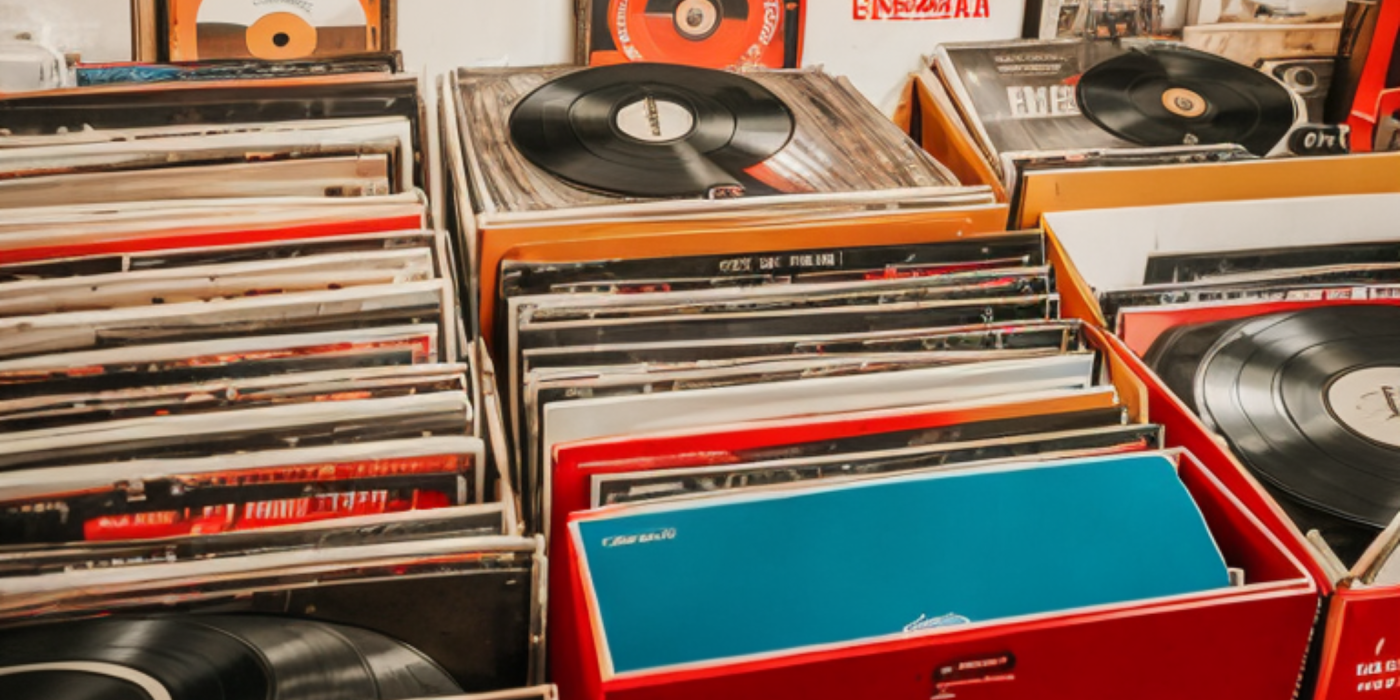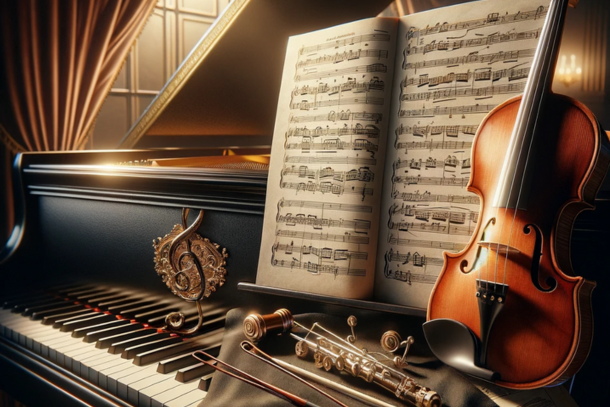Vinyl Records (1877-1990): A Revived Classic Reshaping the Music Industry

Music has always held a special place in our cultural psyche, its formats evolving with the times, each leaving an indelible mark on our collective memory. One such format, the vinyl record, has had a particularly enthralling journey. Born in the late 19th century with the advent of the phonograph and gramophone, vinyl records dominated the music scene for several decades, imprinting their grooves on the fabric of musical history.
Revolving Histories: The Vinyl Record Era
An Era Defined by Vinyl
The era of vinyl records, spanning over a century from 1877 to 1990, witnessed dramatic shifts in technology, culture, and society. The 'vinyl' era truly kicked into gear in the 1950s when the 33 1/3 RPM LP (long play) record was introduced. These records became cultural artefacts, with their large cover art, liner notes, and the unmistakable warmth of the analogue sound. The vinyl record was not just a medium for music; it was a complete sensory experience.
The Unexpected Resurgence
In the digital age, where streaming reigns supreme, one might expect the vinyl record, with its need for specialised equipment and delicate handling, to have gone the way of the dodo. However, contrary to these expectations, we are witnessing a surprising resurgence in the popularity of vinyl. Today, in an era defined by the intangible, there is a growing nostalgia for the tactile and tangible. The vinyl record, with its rich sound and physical presence, seems to satisfy this yearning for a more authentic, sensory connection with music.
In this piece, we will delve into the compelling history of vinyl records, examine their decline, and explore the reasons behind their unexpected comeback. Join us on this riveting journey through the grooves of vinyl history.
In the Beginning: The Birth of Vinyl Records
The Origins and Early Development
The story of vinyl records, or "vinyl" as they're affectionately known, dates back to the late 19th century. The phonograph, invented by Thomas Edison in 1877, was the first machine to record and reproduce sound. However, the phonograph didn’t use vinyl; instead, it etched sound onto tinfoil cylinders. It wasn’t until Emile Berliner introduced the gramophone in the 1880s that flat disc records became popular. Initially, these discs were made from shellac, a material that was brittle and easy to break.
As we journey through the 20th century, the materials used for records began to change. The 1930s saw the introduction of vinyl records, a leap forward due to the material's durability and reduced surface noise. The 12-inch Long Play (LP) vinyl record, introduced by Columbia Records in 1948, was the game-changer, allowing listeners to enjoy an album of music on a single disc for the first time.
The Innovations of the Phonograph and Gramophone
The phonograph and gramophone were groundbreaking inventions in their own right, marking the beginning of a new era of sound recording and reproduction. While the phonograph pioneered the recording and playback of sound, the gramophone popularised the concept of a flat disc record, the form that vinyl records would ultimately take. Both these inventions were instrumental in the birth of vinyl records, paving the way for a revolution in the way we consume music.
In essence, the birth of vinyl records was a combination of innovation, invention, and the enduring human desire for high-quality sound. The legacy of these early developments continues to influence our musical landscape today.
Reviving the Golden Grooves: The Golden Era of Vinyl
Ascension to Popularity
The Golden era of vinyl, spanning from the 1950s to the 1970s, marks a fascinating period in music history. Following the Second World War, the world was primed for cultural change and music was at the heart of this transformation. Vinyl records, with their high-quality sound and enduring nature, fit perfectly into this evolving landscape.
During this period, the popularity of vinyl records soared. With advances in technology, notably the development of the microgroove LP (long-playing) record, vinyl offered listeners the chance to enjoy a broader range of music at home. The LP, with its longer playing time, allowed for full albums, thereby changing the way artists created music and how consumers enjoyed it.
The Cultural and Social Impact
The cultural and social impacts during the golden era of vinyl were profound. Vinyl records became synonymous with the revolutions of pop culture. From the rise of rock 'n' roll and the swinging sixties, through to the disco and punk movements of the seventies, vinyl was there, providing the soundtrack to societal change.
Vinyl records were more than just carriers of music; they were artefacts of their time. Album art became a form of expression, often iconic and reflective of the societal mood. Listening to vinyl became a ritualistic experience - an act of communal enjoyment or personal introspection.
In essence, the golden era of vinyl is not only a significant chapter in the history of music technology, but also an integral part of our cultural and social narrative.
The Allure of the Groove: Unpacking the Unique Qualities of Vinyl Records
The Unparalleled Sound and Tactile Experience
Vinyl records have always been lauded for their exceptional sound quality. Unlike digital formats, vinyl captures the richness and depth of music in its truest form. Audiophiles argue that the 'warmth' of vinyl sound cannot be replicated by any digital format. This 'warmth' refers to the full-bodied, slightly fuzzy sound that vinyl enthusiasts find infinitely more satisfying than the clinical precision of digital audio.
Moreover, vinyl offers a tactile, multi-sensory experience that is often missing in today's world of digital streaming. There's something inherently satisfying about the process of removing a record from its sleeve, carefully placing it on the turntable, and gently lowering the needle onto the groove. This hands-on interaction with music adds a layer of intimacy and personal engagement that simply doesn't exist with digital formats.
Album Art and Liner Notes: A Visual Treat
In addition to the auditory pleasures, vinyl records offer a visual treat in the form of album art and liner notes. The large format of vinyl records provides a canvas for stunning artwork, turning each album into a piece of art in its own right. Liner notes offer insights into the creative process behind the music, often featuring lyrics, credits, and personal anecdotes from the artists.
In essence, the unique qualities of vinyl records extend beyond just the music. They encapsulate an all-encompassing, sensory experience that resonates with listeners on multiple levels. This is perhaps why, despite advances in technology, vinyl continues to hold a special charm for music lovers worldwide.
The Fall of the Turntable: The Decline of Vinyl Records
Contributing Factors to the Decline
The golden age of vinyl couldn't last forever. By the 1980s, the landscape of music consumption was shifting rapidly. The emergence of cassette tapes offered music listeners portability and the ability to create personalised mixtapes. This novelty greatly appealed to the public, leading to a boom in cassette sales.
However, it was the arrival of the Compact Disc (CD) in the mid-1980s that dealt the most significant blow to the vinyl market. CDs, with their promise of superior sound quality, durability, and larger storage capacity, seemed to make vinyl records feel antiquated and cumbersome.
Moreover, the convenience of CDs was undeniable. No longer did music fans need to flip records halfway through an album. Nor did they have to worry about the delicate handling that vinyl required. CDs, unlike vinyl records, were seen as robust and user-friendly, leading to a major shift in consumer preference.
The combined impact of cassette tapes and CDs caused a sharp decline in the popularity of vinyl. By the early 1990s, the production of vinyl records had reduced dramatically, and it appeared that the era of the vinyl record was coming to an unfortunate end.
So, it was during this period that the decline of vinyl records truly took hold. As technological advancements were embraced, vinyl seemed to be relegated to a nostalgic novelty, a relic of a bygone era. But, as we now know, this was far from the end of the story for vinyl.
Back in the Groove: The Resurgence of Vinyl Records
The Current Revival
In a rather surprising turn of events, we are witnessing a vinyl resurgence in the present day. The 2010s marked the beginning of a comeback that no one quite expected. While we live in a world dominated by digital music formats and streaming services, the once-outdated vinyl records are now back in vogue. Sales figures are showing an upswing, with younger generations joining older enthusiasts in rediscovering the charm of vinyl.
The Role of Nostalgia and Quality
The vinyl resurgence isn't just a mere trend; it's a testament to the timeless appeal of these black discs. One key factor is nostalgia. For many, vinyl records invoke a sense of romanticism and a longing for a simpler time. They provide a physical, tactile interaction with music that digital formats can't replicate.
Quality, too, plays a significant role in vinyl's comeback. Audiophiles argue that vinyl records offer superior sound, characterised by warmth and depth that digital tracks often lack. Moreover, the sheer joy of owning a tangible piece of music, complete with album art and liner notes, adds to the overall experience.
In conclusion, the vinyl resurgence is not just about an old format making a comeback. It's a phenomenon that speaks volumes about our relationship with music. It’s a testament to how, despite advances in technology, there's still a place for tradition and a desire for quality in our ever-evolving music consumption habits.
From Grooves to Revival: Contemplating the Future of Vinyl Records
A Recap: From Inception to Resurgence
The journey of vinyl records is as rich and profound as the music they have immortalised. From the rudimentary phonographs of the late 19th century to the sleek turntables of the 21st, vinyl records have been a pivotal part of our musical landscape. They enjoyed a golden era in the mid-20th century, becoming synonymous with some of the greatest musical movements of the time. However, the advent of newer formats such as cassette tapes and CDs in the latter part of the century led to their decline. Yet, as we stand in the present day, vinyl records are enjoying a resurgence, proving their timeless appeal in an age of digital streaming.
Vinyl's Enduring Impact and Its Future
The lasting impact of vinyl records on the music industry is undeniable. They transformed the way music was consumed and appreciated, adding a tactile, visual, and auditory richness that other formats have struggled to replicate. Today, their appeal lies in their authenticity, the warmth of their sound, and the nostalgia they evoke, leading to their unexpected revival.
As for the future of vinyl records, their current popularity suggests a promising trajectory. While digital formats may dominate daily listening, vinyl has found a niche amongst audiophiles, collectors, and those seeking a more immersive and physical engagement with music. In conclusion, despite its dips and rises, the journey of vinyl records is far from over. Their enduring presence underscores not only their historical significance but also their potential to remain a cherished part of our musical future.
Related to this article are the following:
I do hope you have enjoyed this article and hope that you will subscribe to my newsletter so you can get the latest information about all things naturally relaxing.
Stay in touch, join the Naturally Relaxing Newsletter
Newsletter Signup
Post Your Comments
or post as a guest
Be the first to comment.
Latest articles in Music

Serene Symphony: Exploring 10 Timeless Classical Pieces for Unwavering Tranquillity

The Best Music for Meditation: A British Expert's Guide to Deepening Your Practice

The Best Music for Studying: An Expert's Guide to Optimal Concentration & Memory Boost

Melody & Dreams: The Musical Route to a Restful Night

The Healing Power of Music: Combatting Stress & Anxiety in Modern Britain






